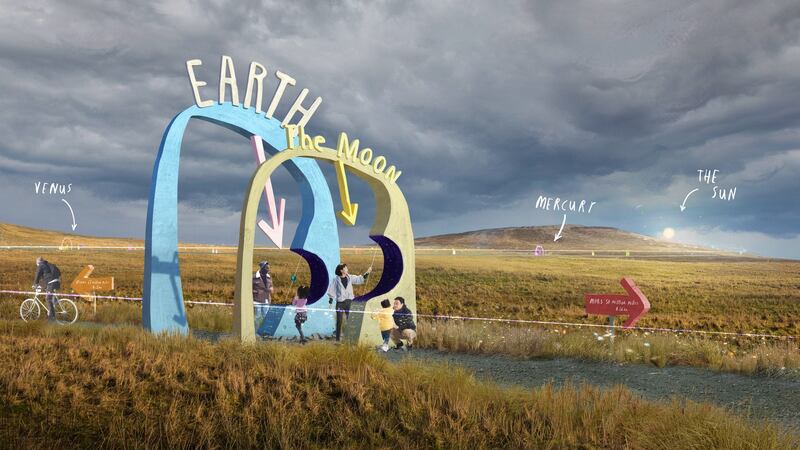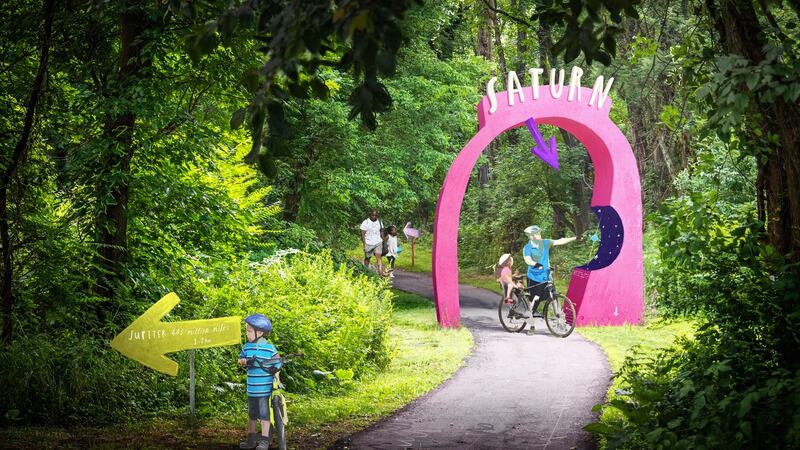“Once there was a boy and the boy loved stars, very much. Every night the boy watched the stars from his window and wished he had one of his very own.”
So begins How to Catch a Star, Oliver Jeffers’s best-selling, multi-translated story of a small boy who sets out to catch a star and make it his friend. Like the protagonists of his burgeoning portfolio of award-winning, beautifully illustrated books for children, the Belfast-born visual artist sees our world as a place of infinite wonder and bright colours, a place for life-changing discovery and adventure.
And yet, for all the visual and intellectual complexities of his internationally acclaimed work as a painter, author, collage and book maker, sculptor, installation and performance artist, he likes to keep things simple.
‘There’s a great deal of simplicity in a lot of the work I do. I try to be more complicated in what I make simple’
Speaking from his Belfast home, having just flown in from New York City, where he lived for 15 years, he concedes that his latest, epic-scale project, Our Place in Space is, in some ways, a natural progression from that much-loved early book, published in 2004.

“You could say that, yes. There’s a great deal of simplicity in a lot of the work I do. I try to be more complicated in what I make simple.”
Our Place in Space, which opens this weekend, is Northern Ireland’s flagship event in UNBOXED: Creativity in the UK, a UK-wide celebration of the creative industries, which runs from March to October. It’s designed to reach millions, to bring people together through a packed programme of free, large-scale events, installations and globally accessible digital experiences. Behind the scenes is a massed gathering of some of the brightest and best scientists, artists, technologists, engineers and mathematicians around.
Unplanned serendipity
Jeffers’s involvement turned out to be a perfect example of unplanned serendipity.
“If not for Covid, Our Place in Space would not exist,” says Jeffers. “We’d been living distantly in New York for some years and came back to Belfast when we received news that my father had contracted the virus. Then came lockdown and we ended up staying.
“I got a call from my brother Rory [also an artist]. He’d been talking to David Lewis [director of communications and digital content] at the Nerve Centre in Derry. They were keen to pitch a project to UNBOXED and asked would I come on board. I told them I wasn’t really interested and they said, ‘You don’t understand how big this is.’ I didn’t and I certainly didn’t realise they were planning to build the whole thing around me. But the idea of working with a tech partner appealed to me, so we put our heads together and gave it a go. And here we are.”
Produced by Nerve Centre Collective and commissioned by UNBOXED with Belfast City Council, it is one of 10 multi-site and digital creative projects, designed to offer new ideas and possibilities for the future. It constitutes a 10km walk through the solar system via a colourful, three-dimensional sculpture trail installed in three of Northern Ireland’s most scenic areas.

En route, the publlc will encounter all manner of intriguing interactive opportunities: to create a star, compose a symphony for the universe, invent a new mode of transport, build a planet or link up with space watchers around the world. The whole experience is aimed at taking a fresh look at our planet and thinking about how we might better share and protect it into the future.
As the project’s creative director, Jeffers worked in close collaboration with Queen’s University Belfast professor of astrophysics Stephen Smartt – also a Belfast man – and the exciting Irish instrumentalist, sound artist and film-maker Die Hexen, whose atmospheric, unearthly compositions have won widespread praise, including from film critic Mark Kermode, who declared her “a composer whose name you should know”.
Working together, Jeffers and Smartt have developed an engaging way of communicating complex scientific concepts and were inspired by this quote from the American author and space philosopher Frank White’s book, The Overview Effect: Space Exploration and Human Evolution: “We are going to have to start acting as one species with one destiny – we’re not going to survive if we don’t do that.”

“The overview effect is a cognitive shift in awareness, which some astronauts report during spaceflight. It’s often experienced when they view Earth from outer space,” explains Jeffers.
Perspective
“The title, Our Place in Space, is intended to humanise our experience of the universe, to lend scale and perspective to the way we regard our own place in it. I also see it as offering an opportunity to speak about Northern Ireland politics with distance and objectivity.
“When we lived in New York, it became obvious to me that nobody there understood or cared about the politics and geography of Northern Ireland. Physical distance gives you a similar sense of overview as that experienced by astronauts.”
Jeffers and Smartt argue that, as human beings, we define ourselves as who we are and who we are not by, for example, the team we support, the place we live in, the things we believe in and fight for. In the process, we end up operating on an “us and them” mentality – something, they agree, that people from Northern Ireland know all about.

In a catchy video, illustrated by Jeffers’s quirky handwritten captions and humorous drawings, Smartt provides the hard scientific facts. The International Space Station is 240 miles away, straight up. It is from that point that astronauts may start to experience the overview effect, where it becomes obvious that our planet is one massive single system.
He explains that it is a quarter of a millions miles to the moon, that our nearest planet Venus is 26 million miles away and about the same size as Earth, that Neptune is the most distant planet at some 2.6 billion miles. He dismisses Pluto as “a dwarf planet”. To get to the edge of our solar system, you’d need to travel 9 billion miles.
As Jeffers remarks in response: “It’s very hard to contemplate how much space there is in space. It’s almost impossible to have a scale model of our solar system. If Earth were the size of a ping-pong ball, the moon would be the size of a pea and, on the same scale, Neptune would be size of a small melon.

“So we are asking what would happen if we could view ourselves alone on our tiny planet, the only one that can harbour life, from the far reaches of our solar system?”
They predict that, with sufficient distance, the notion of “us and them” would simply become become “us”.
Cosmology
Jeffers says that, when he was writing Here We Are in 2017 for his young son, he became interested in cosmology. In the course of his wide-ranging career, he has collaborated with a number of scientists and physicists, with each experience feeding into work as an artist. Elements of a quantum physics assignment found their way into The Incredible Book Eating Boy, which, in 2012, was adapted as a piece of children’s theatre by composer Conor Mitchell and illusionist Paul Bosco McEneaney, artistic director of Cahoots.
‘I always regretted that STEM was not STEAM," says Jeffers. ‘“A” for art is missing and it shouldn’t be’
UNBOXED is very much a celebration of the educational STEM concept, which puts academic and curricular emphasis on the disciplines of science, technology, engineering and mathematics.
“I always regretted that STEM was not STEAM,” says Jeffers. “’A’ for art is missing and it shouldn’t be. That’s what this means to me as an artist right now. It’s always the stories that come first.”
Our Place is Space will certainly be a sight to behold when viewed within the natural beauty of its three Northern Ireland sites – the River Foyle in Derry, Divis and Black Mountains above Belfast and the North Down coastal path – as well as in Cambridge in England.
“You’ll pass through a series of giant archways placed along the route,” says Jeffers. “These objects are pretty enormous. They were fabricated in Greenwich in east London and tookover most of the factory. then they were shipped her to be installed in Derry.
“The practicalities of making this happen have been many and great. Finding a 10km stretch of land, heading in the same direction, was one of the first challenges. It went on from there.
“It’s meant as a playful experiment, encouraging people to come together and reflect on life on Earth and their place in it. It invites us to ask ourselves which side are we on and, with a renewed sense of perspective, to consider whether there should be any ‘sides’ at all.”
Locations:
Bay Road Park and River Foyle, Derry: April 22nd to May 22nd;
Divis and Black Mountain, Belfast: June 11th to July 10th;
Ulster Transport Museum and North Down coastal path: September 17th to- October 16th.
The project also includes an interactive AR app, and major learning and events programmes. ourplaceinspace.earth/
UNBOXED: Creativity in the UK is funded and supported by the four governments of the UK and commissioned and delivered in partnership with Belfast City Council, Creative Wales and EventScotland.











